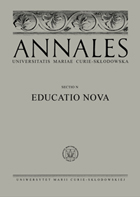Diagnostyka parametrów sylaborytmicznej struktury mowy
u dzieci przedszkolnych z zaburzeniami kompleksowymi
Diagnostics of the Parameters of the Syllaborhythmic Speech Structure in Pre-School Children with Complex Disoders
Author(s): Nataliia Babych, Kateryna TychynaSubject(s): Social Sciences, Education, Inclusive Education / Inclusion, Pedagogy
Published by: Wydawnictwo Naukowe Uniwersytetu Marii Curie-Sklodowskiej
Keywords: syllaborhythmic speech structure; syntagmatic constructions; rhythm of speech; pre-school children with complex disoders; speech development disorders
Summary/Abstract: A child’s language development is one of the main factors of the personal formation. The level of personal development determines the formation of social and cognitive skills in children. Speech development disorders, in particular mastering of syntagmatic constructions with different structural complexity, complicates children’s communication with peers and adults and impedes written language development. The purpose of this study is to examine the basic parameters of the compositional rhythmic speech structure (movement, rhythm and space) and to determine its development level in preschool children with multiple disabilities (disabilities in sensory, motor and speech systems). In order to examine these parameters a special technique consisting of four diagnostic units (“rhythmic movement”, “rhythmic space”, “rhythmic pronunciation” and “complex rhythm of speech”) was developed. First, an empirical study for each diagnostic unit was conducted, and the findings suggested that majority of preschool children with sensory, motor and speech disorders have underveloped compositional structure of speech, which requires further targeted interventions. The study found that preschool children with multiple disabilities have a reduced ability to pronounce words with different structural complexity, impaired perception of lexical units and a disturbed ability to perform dynamic and rhythmic serial movements, which indicates an insufficient level of motor, rhythmic and spatial skills development. Then, a correlation analysis was performed, the results of which indicate that the diagnostic units – “rhythmic movement”, “rhythmic space”, “rhythmic pronunciation” – are inextricably linked. When the skills assessed by the above-mentioned diagnostic units are developed, the skills, assessed by the “Complex rhythm of speech” diagnostic unit can begin their development as well. Determination of the child’s functioning level in each diagnostic unit will allow describing the effective strategies to influence parameters of compositional rhythmic speech in children with multiple disabilities based on potential capabilities and their maximal implementation in the speech therapy process.
Journal: Annales UMCS Sectio N Educatio Nova
- Issue Year: 6/2021
- Issue No: 1
- Page Range: 359-376
- Page Count: 18
- Language: English

